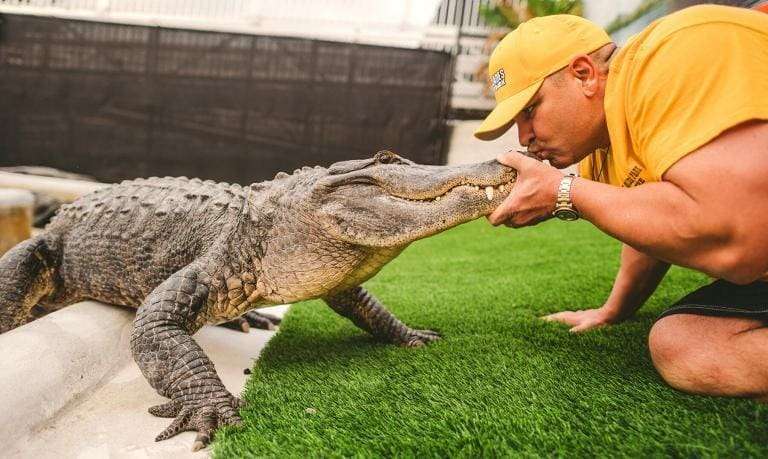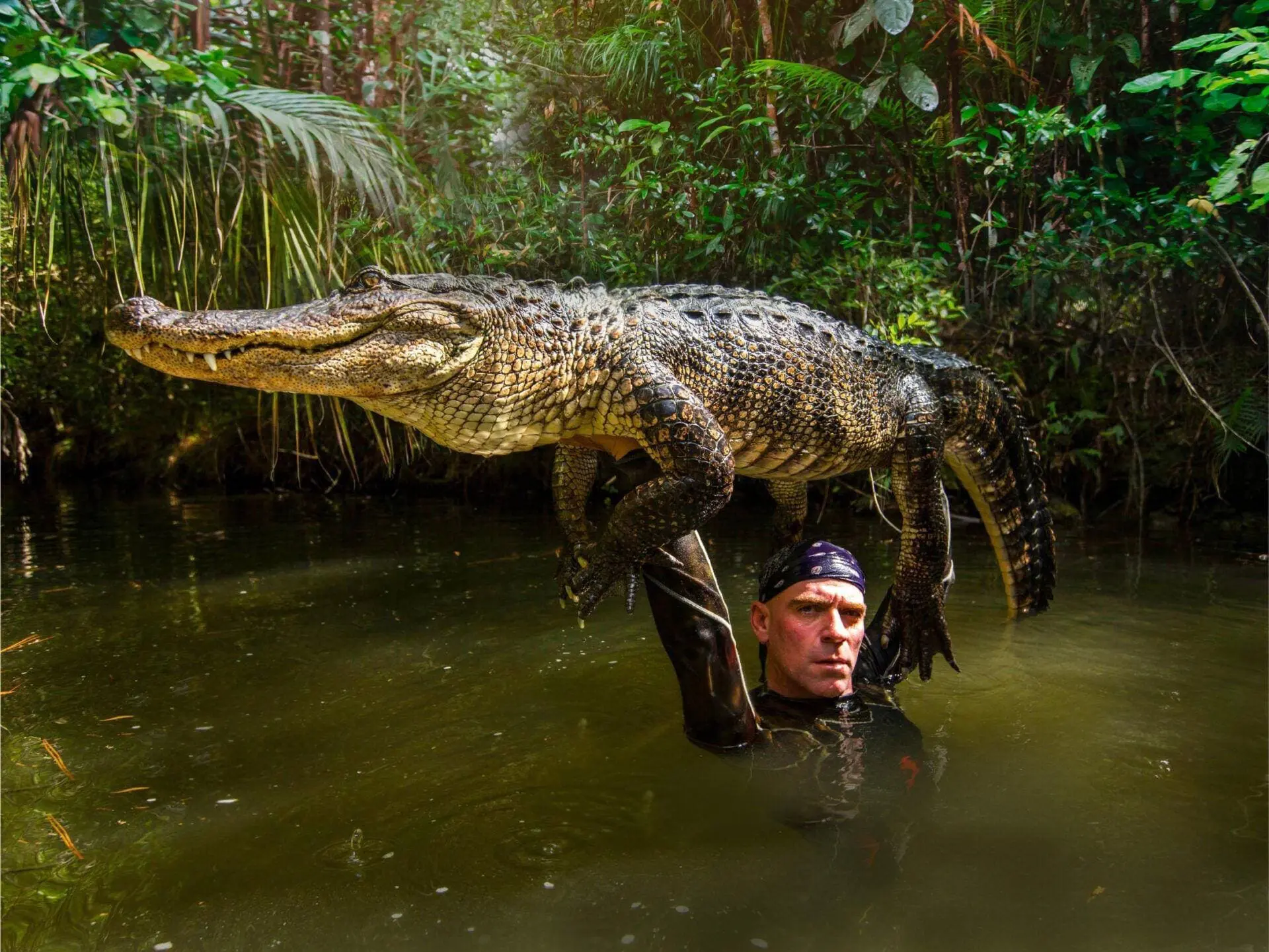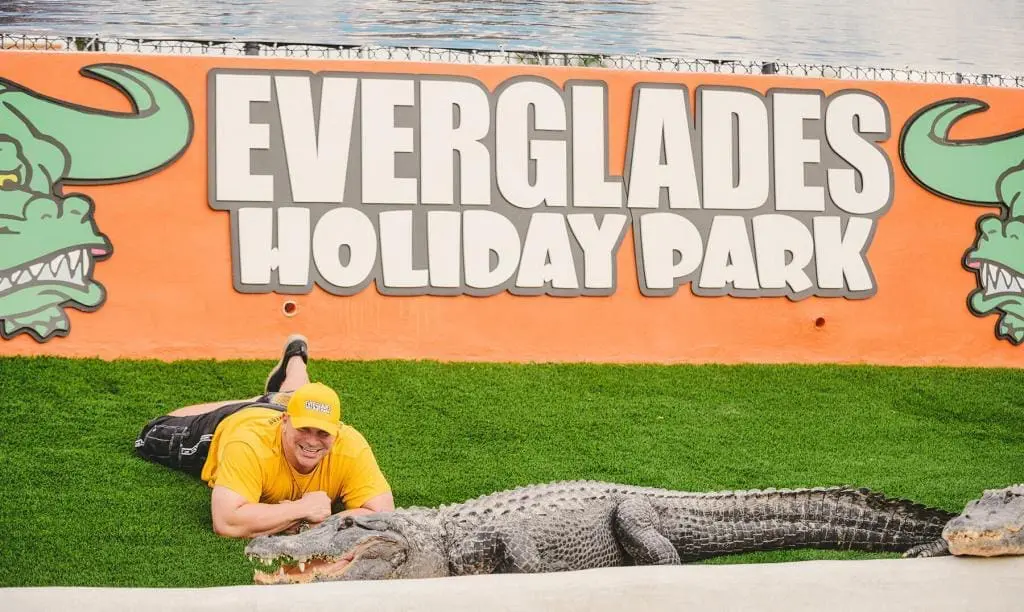
GATOR BOYS ALLIGATOR RESCUE
LIVE GATOR SHOW
Watch a LIVE, 20-Minute Alligator Show Featuring the World-Famous Gator Boys Alligator Rescue team in our world-famous pit
GATOR BOYS GATOR SHOW!
We believe in offering more than just downright thrilling airboat tours through the Everglades. We also believe in providing a safe haven and animal sanctuary for rescued alligators who have found their way into pools, garages, backyards, and even bedrooms in Florida! Our one-of-a-kind LIVE Gator Shows are performed by the world-famous Gator Boys Alligator Rescue team. This rescue team of gator trapping experts not only hand-captures these alligators but has also been featured on Animal Planet’s hit show! In fact, many of the show’s episodes have been filmed right here at our park! Drop by, say hello, and enjoy our thrilling show as the Gator Boys perform stunts, tricks, and jaw-dropping feats with these rescued gators.
WATCH A LIVE, 20-MINUTE ALLIGATOR SHOW FEATURING THE WORLD-FAMOUS GATOR BOYS ALLIGATOR RESCUE TEAM IN OUR WORLD-FAMOUS PIT
Watch as the famous Gator Boys perform wild, exhilarating stunts and tricks with our rescued American alligators. These alligators would have been harvested for their meat and hides if it were not for us giving them a place to live
The live alligator show is included with each Everglades airboat tour ticket purchase. You can also purchase standalone gator show tickets here at the park if you only want to take in the gator show without going on an airboat tour.

THE GATOR BOYS MISSION AT EVERGLADES HOLIDAY PARK
LIVE GATOR BOYS ALLIGATOR SHOW IN OUR WORLD-FAMOUS GATOR PIT
All of our Everglades airboat adventures here at Everglades Holiday Park include one of the thrilling Everglades gator wrestling shows from the world-famous Gator Boys Alligator Rescue team! For 20 awe-inspiring minutes, you’ll witness a wildlife show adventure unlike any you’ve ever seen.
You’ll get to see a jaw-dropping, up-close and personal glimpse into the behavior and mannerisms of our rescued American alligators. Our exciting and educational LIVE alligator shows are one-of-a-kind, no matter who’s performing that day! When our expertly trained alligator handlers are on center stage with these amazing animals, guests are guaranteed a wild adventure unlike any other!
GATOR BOYS ALLIGATOR RESCUE GALLERY






THE GATOR BOYS ALLIGATOR RESCUE IN THE FLORIDA EVERGLADES
We’re extremely proud to host an animal sanctuary and safe haven for rescued alligators here at the park, located in South Florida. The Gator Boys Alligator Rescue is a direct reflection of our commitment and dedication to educating the public on the importance of continued conservation and preservation efforts for our beloved Everglades ecosystem.
By providing a space for the talented and conservation-conscious Gator Boys Alligator Rescue team, we hope to showcase just how much positive influence this rescue team has and encourage others to contribute to the ongoing preservation of the Everglades ecosystem, too.

LIVE GATOR BOYS ALLIGATOR SHOWS
Our alligator shows are performed by the Gator Boys Alligator Rescue team in our alligator pit with stadium-style seating and a mechanical louvered covered roof that provides maximum shade and coverage from the powerful South Florida sunshine. Every Everglades airboat tour ticket purchase includes access to our 20-minute alligator show, where you’ll watch our expert alligator handlers perform tricks and stunts, all while teaching you all about the American alligator!
FEATURED ON ANIMAL PLANET
Gator Boys, a team of experienced wranglers working out of their home base in our Everglades Holiday Park, were first featured on Animal Planet in 2012. The Gator Boys are shown wrestling alligators out of places those animals shouldn’t be. Their final episode aired in February of 2015 and showed the Gator Boys advocating for and pressing on policy reform for safe habitation of alligators.
EXHILARATING PERFORMANCES
The show includes many jaw-dropping, up close and personal looks at the behavior and mannerisms of American alligators. One of the tricks called the “face off” includes a Gator Boy holding the gator’s mouth shut with his chin!
A UNIQUE WILDLIFE EXPERIENCE
The most exceptional thing about these shows is that they aren’t just for entertainment purposes. Every show is interwoven with education so that the viewers better understand alligators, how to protect their environment, and how to act when seeing an alligator in the wild.
PRESERVING THE EVERGLADES
The Everglades ecosystem is subtropical wetlands spanning two million acres over central and south Florida. During the wet season, late May through June, Lake Okeechobee overflows into a shallow, slow-moving river affectionately named the “River of Grass” because of how dominated it is by sawgrass marsh. The water flows southward through many diverse habitats until it reaches Everglades National Park and then Florida Bay.
Originally, the Greater Everglades ecosystem was made up of a large diversity of habitats all connected by bodies of water and wetlands. However, since the 1800s, humans have been changing the Everglades landscape, unintentionally as well as intentionally. Water diversions and flood control structures, while important for human settlements, restrict the flow of water across what is a sensitive landscape. Once you factor in agricultural and urban developments as well, it’s not hard to see how the Everglades have decreased in size, which affects the quality of the included habitats.
By providing the Gator Sanctuary for the talented and conservation-conscious Gator Boys, we hope to showcase just how much positive influence this rescue team has by educating and encouraging viewers to contribute to the ongoing preservation of the Everglades ecosystem.
THE ULTIMATE ALLIGATOR EXPERIENCE
Encountering alligators in the wild can be scary and intimidating, especially as a visitor to Florida. These shows are the perfect way to get educated about alligators and have an immersive experience that will create lifelong memories.

READY FOR YOUR EVERGLADES ADVENTURE?
Animal Encounters & Everglades VIP Tour Pick-up service:
Open 9:00 AM - 4:00 PM daily. Park hours are subject to unpredictable weather.
Park Info:
Open 9:00 AM - 4:00 PM daily. Park hours are subject to unpredictable weather.
BAIT & TACKLE AND GENERAL STORE HOURS:
7 Days a week: 7:00 AM – 7:00 PM Eastern Time
AIRBOAT TOURS & GATOR SHOW HOURS:
7 Days a Week: We open at 9:00 AM Eastern Time (rain or shine). *Tours are approximately 60-minutes long. Our last airboat tour departs promptly at 4:00 PM Eastern Time SHARP! Please arrive no later than 3:30 PM to receive the full tour experience.
PARK PRICING:
**All prices are subject to change without notice at our discretion. Please call our office directly for the most up-to-date pricing information.







